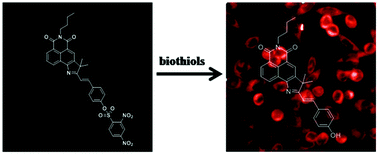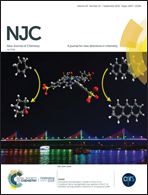A naphthalimide-indole fused chromophore-based fluorescent probe for the detection of biothiol with red emission and a large Stokes shift†
Abstract
In this work, a fluorescent probe, 1, using naphthalimide-indole as a fluorophore and a 2,4-dinitrobenzene sulfonyl group as a recognition site for biothiols (GSH, Cys and Hcy) was developed. The probe can work in aqueous media with a rapid response time (within 4 min). In the detection of biothiols, the probe showed red emission (590 nm), low detection limits (8.97 × 10−9 M for GSH, 9.87 × 10−9 M for Cys, and 1.02 × 10−8 M for Hcy) and a 143 nm Stokes shift. Moreover, this probe exhibited potential practical applications for detecting biothiols in living cells.



 Please wait while we load your content...
Please wait while we load your content...